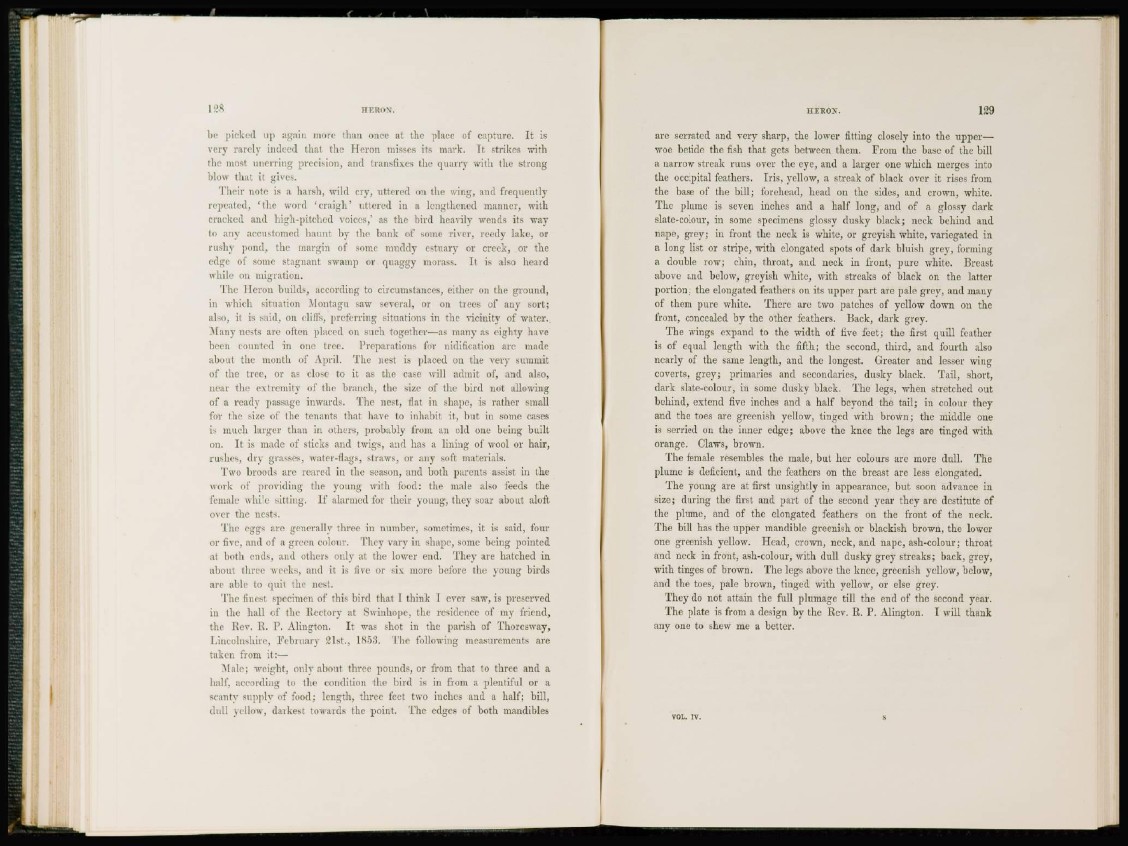
1 is H E R O N .
bo picked up again more than once at the place of capture. It is
very rarely indeed that the Heron misses its mark. It strikes with
tlio most unerring precision, and transfixes the quarry with the strong
blow that it gives.
Their note is a harsh, wild cry, uttered on the wing, and frequently
repeated, 'the word ' c r a i g h ' uttered in a lengthened manner, with
cracked and high-pitched voices,' as the bird heavily wends its way
to any accustomed haunt by the bank of some river, reedy lake, or
rushy pond, the margin of some muddy estuary or creek, or the
edge of some stagnant swamp or quaggy morass. It is also heard
while on migration.
The Heron builds, according to circumstances, either on the ground,
in which situation Montagu saw several, or on trees of any sort;
also, it is said, on cliffs, preferring situations in the vicinity of water..
Many nests are often placed on such together—as many as eighty have
been counted in one tree. Preparations for nidificatiou are made
about the month of April. The nest is placed on the very summit
of the tree, or as close to it as the case will admit of, and also,
near the extremity of the branch, the size of the bird not allowing
of a ready passage inwards. The nest, flat in shape, is rather small
for the size of the tenants that have to inhabit it, but in some cases
is much larger than in others, probably from an old one being built
on. It is made of sticks and twigs, and has a lining of wool or hair,
rushes, dry grasses, water-flags, straws, or any soft materials.
Two broods are reared in the season, and both parents assist in the
work of providing the young with food: the male also feeds the
female while sitting. If alarmed for their young, they soar about aloft
over the nests.
The eggs arc generally three in number, sometimes, it is said, four
or five, and of a green colour. They vary in shape, some being pointed
at both ends, and others only at the lower end. They are hatched in
about three weeks, and it is five or six more before the young birds
are able to (put the nest.
The finest specimen of this bird that I think T ever saw, is preserved
in the hall of the Rectory at Swinhope, the residence of my friend,
the Rev. R. F. Alington. It was shot in the parish of Thoresway,
Lincolnshire, February 21st., 1853. The following measurements are
taken from it:—
Male; weight, onlv about three pounds, or from that to three and a
half, according to the condition the bird is in from a plentiful or a
scanty supply of food; length, three feet two inches and a half; bill,
dull yellow, darkest towards the point. The edges of both mandibles
HERON. 129
are serrated and very sharp, the lower fitting closely into the upper—
woe betide the fish that gets between them. From the base of the bill
a narrow streak runs oyer the eye, and a larger one which merges into
the occipital feathers. Iris, yellow, a streak of black over it rises from
the base of the bill; forehead, head on the sides, and crown, white.
The plume is seven inches and a half long, and of a glossy dark
slate-colour, in some specimens glossy dusky black; neck behind and
nape, grey; in front the neck is white, or greyish white, variegated in
a long list or stripe, with elongated spots of dark bluish grey, forming
a double row; chin, throat, and neck in front, pure white. Breast
above and below, greyish white, with streaks of black on the latter
portion; the elongated feathers on its upper part are pale grey, and many
of them pure white. There are two patches of yellow down on the
front, concealed by the other feathers. Back, dark grey.
The wings expand to the width of five feet; the first quill feather
is of equal length with the fifth; the second, third, and fourth also
nearly of the same length, and the longest. Greater and lesser wing
coverts, grey; primaries and secondaries, dusky black. Tail, short,
dark slate-colour, in some dusky black. The legs, when stretched out
behind, extend five inches and a half beyond the tail; in colour they
and the toes are greenish yellow, tinged with brown; the middle one
is serried on the inner edge; above the knee the legs are tinged with
orange. Claws, brown.
The female resembles the male, but her colours arc more dull. The
plume is deficient, and the feathers on the breast are less elongated.
The young are at first unsightly in appearance, but soon advance in
size; during the first and part of the second year they arc destitute of
the plume, and of the elongated feathers on the front of the neck.
The bill has the upper mandible greenish or blackish brown, the lower
one greenish yellow. Head, crown, neck, and nape, ash-colour; throat
and neck in front, ash-colour, with dull dusky grey streaks; back, grey,
with tinges of brown. The legs above the knee, greenish yellow, below,
and the toes, pale brown, tinged with yellow, or else grey.
They do not attain the full plumage till the end of the second year.
The plate is from a design by the Rev. R. P. Alington. I will thank
any one to shew me a better.